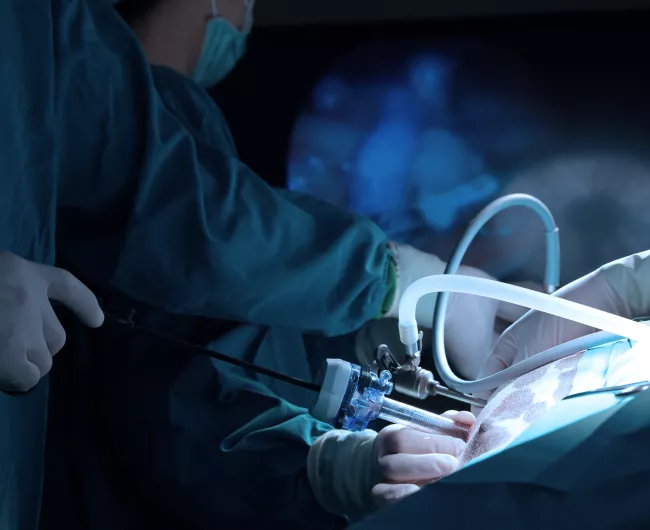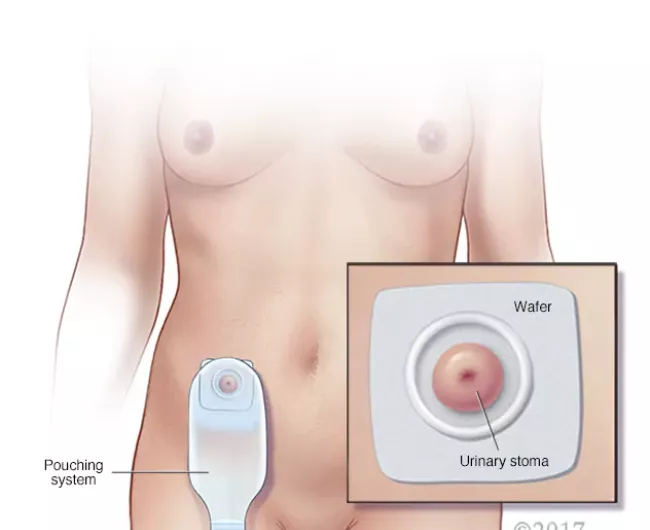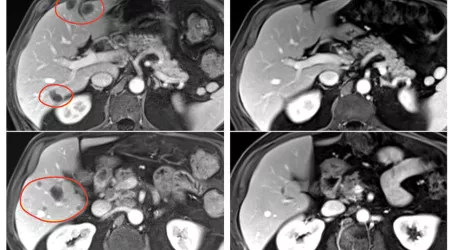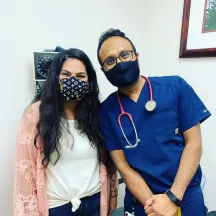Why an ostomy?
Many colorectal cancer patients will have a temporary ostomy after surgery but less than 10% of patients will end up having a permanent ostomy.

Emotional challenges
Think of your ostomy’s function as you did your natural bowel movements. You still have the same bowel; it just might be redirected for a little while. The real change is having stool come out of an opening made on your stomach.

Before surgery
Before your ostomy surgery, you and your surgeon will discuss the best place for your stoma. They will examine your abdomen will you are in different positions – sitting, standing, or lying down.
The stoma is usually placed below the waistline, in the lower part of the abdomen.
If you have obesity, the stoma may be placed above the waistline.

Ostomy placement
There are several factors that affect where your stoma is placed. Your surgeon will place it in location that:
- Is easy for you to see and reach
- Does not interfere with your waistband, belt, or other tight pieces of clothing
- Does not affect activities or sports you participate in
- Lowers the risk of complications after your surgery

During surgery
Your ostomy is often created by your surgeon during a colectomy. You will be under general anesthesia, and the surgery may a laparoscopic,robotic-assisted, or an open procedure.

After surgery
Most people recover from ostomy surgery with few difficulties.
You will have a stoma visible on your abdomen. The stoma looks like a small, pink circle about the size of a quarter. It may be flat against your body or protrude out a bit. The stoma will be connected to a pouch that has an opening where it can be emptied.
Digestive changes with an ostomy
You may notice some changes in your digestive system after your stoma surgery:
- Your stool may be less formed than before.
- You many have more gas.
- You may experience constipation or diarrhea.
- If your entire colon was removed, your may feel as if you still need to have a bowel movement, even though the rectum was removed. This is called phantom rectum and is a normal sensation after surgery.
- If your anus was bypassed but not removed, the lining of the bowel will still produce mucous. This may leak out of your anus and be uncomfortable at times.
As your digestive tract heals, these symptoms should improve or lessen over time. Be sure to talk to your doctor about any changes you notice and let them know if these changes are troublesome.
Possible complications
As with any surgery, complications are rare but may arise. In addition to infection and bleeding, there are some specific complications that can occur after a stoma is placed.
Contact your doctor right away if you notice any of the following:
- Fever
- Chills
- Redness or swelling around the stoma
- Severe pain
- Changes in the stoma’s size, shape, color, or odor
- Bleeding from inside or around the stoma that is bright red, heavy, or doesn’t stop
- Nausea and vomiting that is severe or does not stop
- Passing no gas or stool from a stoma for more than four to six hours along with cramping and nausea
- Severe diarrhea or watery output from the stoma

Caring for your ostomy
An ostomy nurse or other specialist will teach you how to manage the care of your new ostomy.
Before your surgery, ask your surgeon who will be teaching you.
More about ostomy care
Managing your ostomyTop resources

"Clinical trials gave us time": A daughter’s tribute to her mother’s courage
When Kate Shin’s mother faced rectal cancer, clinical trials gave them precious time together. Now, Kate shares her story to encourage access to screening and innovative care, including clinical trials.

2025 ASCO update: Six big studies
The 2025 ASCO Annual Meeting featured several important studies that could change how colorectal cancer is treated, including a pivotal study for BRAF V600E patients.

NIH: Combination immunotherapy shrank GI cancers
A new kind of tumor infiltrating lymphocyte (TIL) therapy improved the treatment’s effectiveness in patients with metastatic GI cancers.





